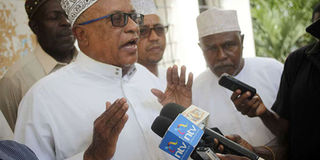Hijab ruling should not derail unity pursuit

Supreme Council of Kenya Muslims coast regional chairman Sheikh Muhdhar addresses a press conference at Mbaruk mosque on January 26, 2019 over the Supreme Court ruling on wearing of hijabs by Muslims girls. PHOTO | FILE | NATION MEDIA GROUP
What you need to know:
- The famous ‘handshake’ between President Kenyatta and Opposition leader Raila Odinga last year was the most unifying act in recent Kenyan history and it reshaped our politics and society.
- The Kenyatta administration has put a greater emphasis on Muslim representation and empowerment than any other.
The Supreme Court decision to overturn a 2016 High Court ruling allowing Muslim girls to wear the hijab in church-run schools has prompted a renewed round of debate on the role of religion and the place of religious pluralism in the country today.
Some welcomed the ruling as having empowered schools to set their own dress code in line with their ethos and values.
They noted that Kenya is not the only country to stipulate dress codes in schools, with rigidly secular France famously banning all expressions of religion — including the hijab — in educational establishments.
Any move to decentralise decision-making in education — shifting power from the State to local providers, who, in theory, know better — is welcome.
TERRORISM
Yet this decision has also attracted a raft of criticism, most notably from Senior Counsel Ahmednasir Abdullahi, who said it was “inspired by a poisonous evangelical jurisprudence that repudiates the rights of Muslim pupils to wear a hijab”, and described it as an expression of Islamophobia.
No doubt, whatever the rights and wrongs of the case, forbidding young women from wearing religious attire that is intended to ‘preserve dignity’ does not look great.
Moving beyond the specific legal arguments, the timing of this ruling was unfortunate.
Little more than a week before, between four and six men — Kenyan-born and -bred — attacked the DusitD2 complex, killing more than 20 of their compatriots.
If ever Kenya needed to send a message that, irrespective of religion, we are one united people, and that young Muslims have an important and equal role to play in our nation, now was it.
HARMONY
In this context, such a divisive decision (of course, the ruling date was set before the attack) was the opposite of what the society needed to communicate to the Muslim minority.
The great shame here is that the hijab ruling and terror attack have largely obscured and taken attention away from the great strides that the government, and, in particular, President Uhuru Kenyatta, has made in bringing the country together.
The famous ‘handshake’ between President Kenyatta and Opposition leader Raila Odinga last year was the most unifying act in recent Kenyan history and it reshaped our politics and society.
For the first time, we had the main representatives of the four largest communities on the same side, each urging their supporters towards togetherness and tolerance.
INCLUSIVITY
The Kenyatta administration has put a greater emphasis on Muslim representation and empowerment than any other.
A notable example of this is Director of Public Prosecutions Noordin Haji, the point man in the war on corruption, perhaps the most important task of the Uhuru presidency.
Majority Leader Aden Duale noted that “there is no time Muslims have held so many senior positions in government”, the same as Tourism Cabinet Secretary Najib Balala.
Similar praise has come from senior Muslim religious leaders and scholars, including for the major investment in infrastructure projects in northern Kenya and the coast.
And so, while we debate the hijab ruling, and the circumstances that led to a group of young Kenyans to savagely murder their countrymen and women, purportedly in the name of Islam, let us not forget the important progress in our cross-communal relations.
Ms Lesuuda is the Samburu West MP. [email protected]




